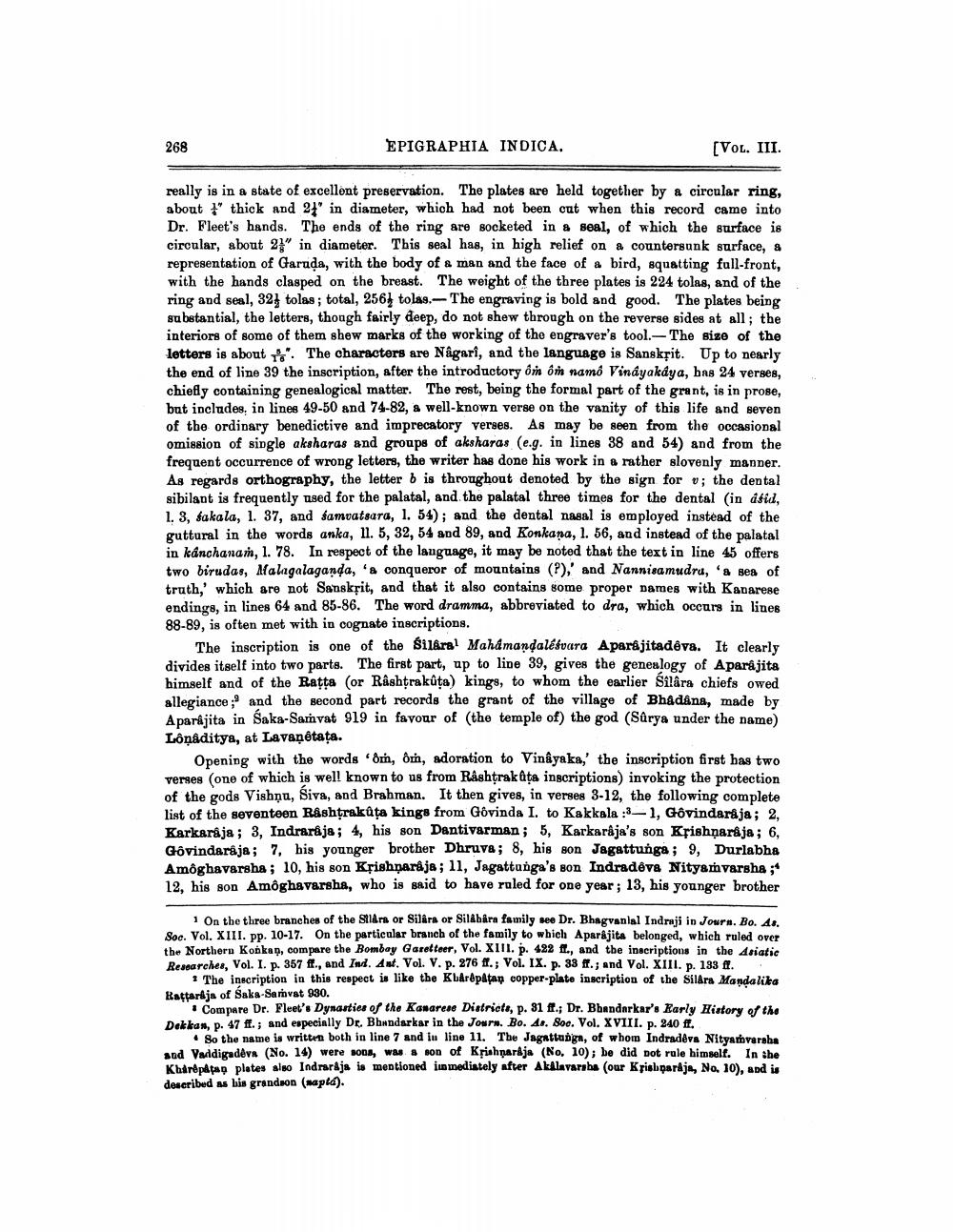________________
268
EPIGRAPHIA INDICA.
(VOL. III.
really is in a state of excellent preservation. The plates are held together by a circular ring, about *" thick and 31' in diameter, which had not been cut when this record came into Dr. Fleet's hands. The ends of the ring are socketed in a seal, of which the surface is circular, about 2}" in diameter. This seal has, in high relief on a countersunk surface, & representation of Garuda, with the body of & man and the face of a bird, squatting full-front, with the hands clasped on the breast. The weight of the three plates is 224 tolas, and of the ring and seal, 32, tolas; total, 2564 tolas. - The engraving is bold and good. The plates being substantial, the letters, though fairly deep, do not shew through on the reverse sides at all; the interiors of some of them shew marks of the working of the engraver's tool. The size of the letters is about ". The characters are Nagari, and the language is Sanskrit. Up to nearly the end of line 39 the inscription, after the introductory ôm ôm namó Vinayakdya, bas 24 verses, chiefly containing genealogical matter. The rest, being the formal part of the grant, is in prose, but includes, in lines 49-50 and 74-82, a well-known verse on the vanity of this life and seven of the ordinary benedictive and imprecatory verses. As may be seen from the occasional omission of single aksharas and groups of aksharas (e.g. in lines 38 and 54) and from the frequent occurrence of wrong letters, the writer has done his work in a rather slovenly manner. As regards orthography, the letter b is throughout denoted by the sign for v; the dental sibilant is frequently used for the palatal, and the palatal three times for the dental (in afid, 1. 3, Sakala, 1. 37, and samvatsara, I. 54); and the dental nasal is employed instead of the guttural in the words anka, 11. 5, 32, 54 and 89, and Konkana, 1. 56, and instead of the palatal in kanchanan, 1. 78. In respect of the language, it may be noted that the text in line 45 offers two birudas, Malagalaganda, 'a conqueror of mountains (?),' and Nannisamudru, a sea of truth,' which are not Sansksit, and that it also contains some proper dames with Kadarese endinga, in lines 64 and 85-86. The word dramma, abbreviated to dra, which occurs in lines 88-89, is often met with in cognate inscriptions.
The inscription is one of the Sil&ral Mahamandalesvara Aparajitadêva. It clearly divides itself into two parts. The first part, up to line 39, gives the genealogy of Aparajita himself and of the Ratta (or Rashtrakůta) kings, to whom the earlier Silara chiefs owed allegiance; and the second part records the grant of the village of Bhadana, made by Aparajita in Saka-Samvat 919 in favour of the temple of) the god (Sürya under the name) Lônaditya, at Lavaņétata.
Opening with the words om, ôm, adoration to Vinayaka,' the inscription first has two verges (one of which is well known to us from Råshtrakata inscriptions) invoking the protection of the gods Vishnu, Siva, and Brahman. It then gives, in verses 3-12, the following complete list of the seventeen Rashtrakata kings from Govinda I. to Kakkala 3-1, Govindaraja; 2. Karkarája; 3, Indraraja; 4, his son Dantivarman; 5, Karkaraja's son Krishnaraja; 6, Govindaraja; 7, his younger brother Dhruva; 8, his son Jagattunga; 9, Durlabha Amoghavarsha; 10, his son Kộishộaraje; 11, Jagattunga's son Indradêva Nityamvarsha ; 12, his son Amôghavarsha, who is said to have ruled for one year; 13, his younger brother
1 On the three branches of the Stars or Silkra or Silåhåra family see Dr. Bhagvanlal Indraji in Journ. Bo. As. Soc. Vol. XIII. pp. 10-17. On the particular branch of the family to which Aparajita belonged, which ruled over the Northern Konkan, compare the Bombay Garetteer, Vol. XIII. p. 422 ft., and the inscriptions in the Asiatic Researches, Vol. I. p. 357 ff., and Ind. Ant. Vol. V. p. 276 .; Vol. IX. p. 33 ff.; and Vol. XIII. p. 133 fr.
The inscription in this respect is like the Klar&patap copper plate inscription of the Sildra Mandalika Rattardja of Saka-Sarvat 930.
Compare Dr. Fleet's Dynasties of the Kanarese Districts, p. 31 ff., Dr. Bhandarkar's Early History of the Dekkan, p. 47 ff.; and especially Dr. Bhandarkar in the Journ. Bo. 41. Soc. Vol. XVIII. p. 240 ft.
So the name is written both in line 7 and in line 11. The Jagattungn, of whom Indradeva Nityamvaraba and Valdigadêra (No. 14) were sus, was a son of Krishnarája (No. 10); be did not rule himself. In the Kharépátaq plates also Indrarája is mentioned in mediately after Akalavaraha (our Krishparaje, No. 10), and is described as his grandson (napta).




